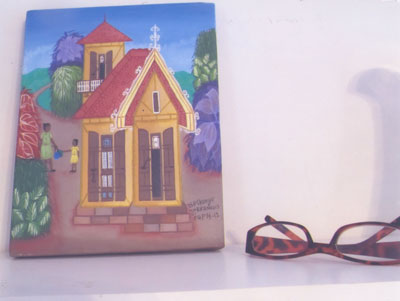Art in Haiti
This item appears on page 52 of the April 2013 issue.
My most recent visits to Haiti were made during Royal Caribbean International cruises in 2010 and 2011, but my son and I first traveled there in 1985. Despite its politics and poverty, Haiti has a very special charm, and nowhere in the country’s colorful history and rich cultural tradition is that more evident than in its art.
Art is a way of life in Haiti. In Port-au-Prince, decoration is everywhere. Townhouses and humble huts are painted in vibrant colors. Cemeteries are multicolored miniature cities. Minibuses (called tap-taps) are painted with religious and country scenes. Fences are lined with paintings leaning against them; much bargaining goes on for this street art.
Most Haitian art is “primitive,” that is to say it’s by unschooled artists, but you also find some impressionistic work. Haitian art is considered a particularly pure genre of folk art and has been shown by top museums around the world.
Paintings by Haiti’s “Grand Old Man,” Philome Obin, have sold at Sotheby’s, but you can do better, pricewise, in Haiti. Other Haitian masters are Hector Hyppolite, Wilson Bigaud, Rigaud Benoit, J.E. Gourgue, Gerard Valcin, Andre Pierre and Prefete Duffaut. There are at least a dozen younger painters who show promise. Whenever possible, I purchase a painting that comes from the Cap Haitien area in the north. This style is unique.
The Haitian art movement is said to have begun in 1944 with the founding of the Centre de Art in Port au Prince. One of my favorite possessions is a book by Selden Rodman written in 1944, “Renaissance in Haiti.” My copy was autographed by at least 14 artists, including the founder of the Centre de Art, DeWitt Peters.
Haiti has always had a special place in my heart. Reading my 1985 journal brought back memories. My son and I had taken every day trip available.
The beaches were pure and lovely. On Sunday afternoons, cockfights were the norm. Dinner at Le Recif was an excellent choice. Unfortunately, it did not survive the 2010 earthquake, although another wonderful “gingerbread palace,” the Grand Hotel Oloffson, did.
At our hotel after dinner, my son enjoyed the 10-cent slots and I took in the fabulous view, the smell of cooking fires and the sounds of roosters announcing their presence. I could hear hotel staff speaking patois in a sort of “clickity-clack.”
Relaxing poolside was the order of the day. We also took a taxi to the Iron Market (reopened in January 2012 after being damaged in the earthquake). Do not miss it! It was quite a shocker to me — baskets, produce, begging and the pure stink of it all. I haggled over two handmade voodoo dolls which eventually were stolen from my luggage.
Having traveled worldwide since that long ago, eye-opening trip to Haiti, I still love the place.
WINNIE SCHALL BAFFA
Leland, NC

